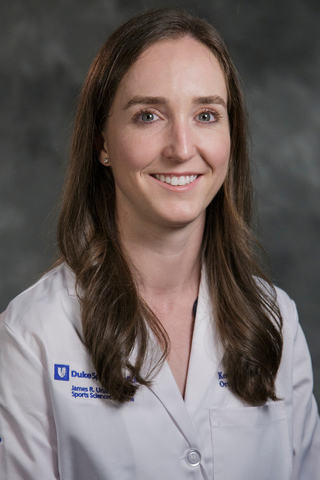With more adolescents specializing and competing at higher levels in sports, childhood injuries have increased as well. Injuries to the ACL are especially common in sports like football, soccer, and lacrosse which involve cutting, pivoting, or rapid changes in movement. The ACL reconstruction techniques used for adults can damage children’s growth plates, and different techniques are needed to spare the physis.
“When adolescents are still growing, especially with several years of growth left, traditional ACL surgery techniques involving the physis can cause growth deformities, limiting the child’s height or how their legs grow,” says Duke orthopedic surgeon Kendall E. Bradley, MD.
Historically the recommendation was to wait to repair the knee after a child reached skeletal maturity in their mid-teens. “However, more and more data show that without reconstruction, if adolescents continue activities after an ACL tear, they’re more likely to sustain cartilage and meniscal damage,” Bradley says.
Physeal-sparing ACL reconstruction techniques ensure injured adolescents can not only recover and return to activity and sport, but also continue to grow correctly.

Physeal-sparing ACL reconstruction procedure
Like other ACL surgeries, physeal-sparing ACL reconstruction is a same-day surgery, allowing patients to leave the hospital within hours of the surgery. Where traditional ACL reconstruction drills directly into the femur and tibia to attach the replacement ligament, the physeal-sparing technique takes the patient’s own iliotibial band and redirects it to take the place of the ACL, attaching directly to the tibia without drilling. This avoids damaging the physis.
After surgery, patients start physical therapy (PT). For patients traveling to Duke, they can continue PT in their own communities as Duke teams coordinate with local providers to help create continuity of care as well as make these procedures accessible to a wider network. For most ACL reconstructions, with PT, they can return to running about four to five months post-surgery and return to full-contact sport without restrictions nine to 12 months after surgery.

To refer a patient, call Duke's Consultation and Referral Center at 800-633-3853 or log into Duke MedLink.
Return to activity, sport vital for adolescents
Adolescents who tear their ACLs in sports prioritize a return to not only daily activities but also contact sport. “It’s easy to dismiss sports injuries as less important,” Bradley says, “but sport can be vital to adolescents’ social networks and mental health. When they’re injured, those areas suffer. We want to make sure we address young patients’ mental health when they receive injuries because it has a huge impact on their lives, beyond just surgery and recovery — it’s also the loss of something they love. There’s a grieving process.”
Bradley is well aware of the impact of injuries on youth in sports: as a high-school athlete in basketball and soccer, she sustained a knee injury. Her treatment at Duke led to an interest in orthopedics, shadowing her surgeon during high school. Bradley went on to attend Duke, playing soccer as an undergraduate and continuing on to medical school there. Her further training took her all over the U.S. to specialize in children’s orthopedics and sports medicine before she returned to Duke. With a multidisciplinary team, Bradley sees patients at both Duke Sports Medicine Cary and Durham and performs the physeal-sparing procedure at Duke Ambulatory Surgery Center in Durham and Duke Arringdon in Morrisville.